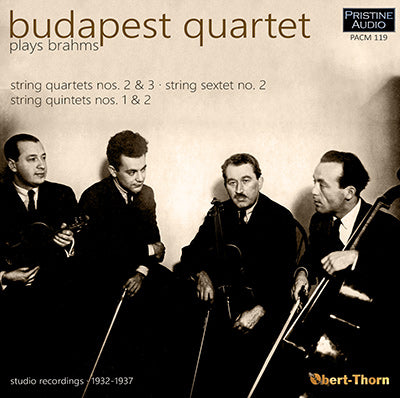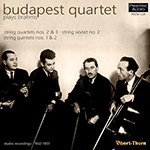
- Producer's Note
- Full Track Listing
- Cover Art
This release is the third in a series which, when finished, will present
the complete pre-war recordings of the Budapest Quartet. One volume with
some of the ensemble’s earliest recordings from the 1920s has already
appeared (on
The Budapest Quartet was founded in 1917 by four members of the Budapest Opera Orchestra, three Hungarians and a Dutchman. By 1932, when the earliest of the recordings presented here was made, only one of the original members (Hungarian violist István Ipólyi) was still in the group, while the other three positions had been taken by Russians (actually two Lithuanians – the Schneider brothers – and the Ukrainian Roisman, all born in what was at the time part of the Russian empire). Their different training styles led to many contentious arguments within the group, which, unusually for the time, developed its interpretations by consensus, with one member designated as an authority for a particular composer to break a tie, if necessary. These disputes usually pitted Ipólyi against the three putative Russians, leading to his departure in 1936. He was replaced by the Ukrainian Boris Kroyt, who is heard in two 1937 recordings presented here (Opp. 36 and 88), and who would continue with the group until it disbanded in 1967.
The behind-the-scenes drama did not carry over into the actual performances, which display a high degree of unanimity of conception and disciplined ensemble playing. Critic Harris Goldsmith likened the quartet to “a kind of chamber music equivalent to that icon of symphonic music, Arturo Toscanini”, writing that their performances “shared with the Italian maestro an easily recognizable (and then distinctly modern) technical brilliance, a certain streamlining of architecture, a pervasive rhythmic virility, unfussy phrasing and momentum [. . .] an analogous lean transparency and vertical clarity, and beautiful intensity and silkiness of tone.”
The Budapest’s first Brahms recordings were made in Berlin toward the end of 1932, most likely in anticipation of the composer’s centenary the following year. The ensemble already had a connection to Brahms through its original cellist, Harry Son, who had studied under David Popper. Popper had been the cellist of the Hubay Quartet, whose members were befriended (and often accompanied in performance) by Brahms. Although Son left the group in 1930, being replaced by Mischa Schneider, the lone original founding member of the quartet, the violist Ipólyi, was still on hand to ensure continuity of approach.
The recordings of the Third Quartet and the Second String Quintet were made simultaneously during these sessions (the matrices of the second and third movements of the Quintet were recorded between the two sides of the Quartet’s first movement, while the rest of the Quintet was taken down between the two sides of the Quartet’s second movement). The guest violist was the German Hans Mahlke. The tempo of the Quartet’s first movement was energetic enough to allow a repeat, something the Budapest did not observe in their more broadly-paced LP remake in 1954.
The next Brahms recording made by the Budapest was the Second Quartet in 1935. They would probably have gone onto record the First Quartet had HMV not already had the Busch Quartet’s version in their catalog. Their final prewar Brahms recordings were made at back-to-back sessions in 1937. The Second String Sextet (the Budapest’s only recording of the work) was set down with British violist Alfred Hobday and Argentine-British cellist Anthony Pini, followed the next day by First String Quintet with Hobday alone. It would not be until 1950 that a new Budapest Quartet Brahms recording would appear, after more personnel changes in the group had taken place.
BUDAPEST QUARTET plays Brahms
CD 1 (74:00)
BRAHMS
String Quartet No. 2 in A minor, Op. 51, No. 2
1. 1st Mvt. – Allegro non troppo (8:46)
2. 2nd Mvt. – Andante moderato (9:25)
3. 3rd Mvt. – Quasi Minuetto, moderato – Allegretto vivace (5:18)
4. 4th Mvt. – Finale: Allegro non assai (7:00)
Recorded 30 April & 1 May 1935 in Abbey Road Studio No. 3, London
Matrix nos.: 2EA 2041-1, 2042-1, 2045-1, 2046-2, 2047-2, 2048-2, 2049-1
& 2050-2
First issued as HMV DB 2907/10
BRAHMS
String Quartet No. 3 in B flat major, Op. 67
5. 1st Mvt. – Vivace (8:29)
6. 2nd Mvt. – Andante (7:40)
7. 3rd Mvt. – Agitato (Allegretto non troppo) (8:02)
8. 4th Mvt. – Poco Allegretto con Variazioni (8:45)
Recorded 15, 17 & 18 November 1932 in the Beethovensaal, Berlin
Matrix nos.: 2D 1270-1, 1274-1, 1275-1, 1283-1, 1284-1, 1285-1, 1286-1
& 1287-1
First issued as HMV DB 1859/62
BRAHMS
String Sextet No. 2 in G major, Op. 36*
9. 1st Mvt. – Allegro non troppo (10:31)
CD 2 (72:04)
1. 2nd Mvt. – Scherzo: Allegro non troppo – Presto giocoso (7:24)
2. 3rd Mvt. – Adagio (8:28)
3. 4th Mvt. – Poco allegro (6:11)
Alfred Hobday (viola II); Anthony Pini (cello II)
Recorded 8 February 1937 in Abbey Road Studio No. 3, London
Matrix nos.: 2EA 4594-1, 4595-1, 4596-1, 4597-1, 4598-1, 4599-1, 4600-1
& 4601-1
First issued as HMV 3139/42
BRAHMS
String Quintet No. 1 in F major, Op. 88*
4. 1st Mvt. – Allegro non troppo ma con brio (8:35)
5. 2nd Mvt. – Grave ed appassionato – Allegro vivace – Presto (12:05)
6. 3rd Mvt. – Allegro energico – Presto (5:13)
Alfred Hobday (viola II)
Recorded 9 February 1937 in Abbey Road Studio No. 3, London
Matrix nos.: 2EA 4803-2, 4804-1, 4805-2, 4806-1, 4807-1 & 4808-1
First issued as HMV DB 3143/5
BRAHMS
String Quintet No. 2 in G major, Op. 111
7. 1st Mvt. – Allegro non troppo, ma con brio (8:16)
8. 2nd Mvt. – Adagio (6:52)
9. 3rd Mvt. – Un poco allegretto (4:31)
10. 4th Mvt. – Vivace ma non troppo presto (4:22)
Hans Mahlke (viola II)
Recorded 15 & 17 November 1932 in the Beethovensaal, Berlin
Matrix nos.: 2D 1280-1, 1281-1, 1271-2, 1272-1, 1273-2 & 1282-1
First issued as HMV DB 1866/8
Budapest String Quartet
Joseph Roisman (violin I)
Alexander Schneider (violin II)
István Ipólyi or *Boris Kroyt (viola)
Mischa Schneider (cello)
Producer and Audio Restoration Engineer:
Special thanks to Nathan Brown, Charles Niss and David Schmutz for
providing source material
Cover picture based on a photo of the Budapest Quartet
(L-to-R: Roisman, A. Schneider, Ipolyi, M. Schneider) courtesy of the Tully
Potter Collection
Total duration: 2hr 26:04

